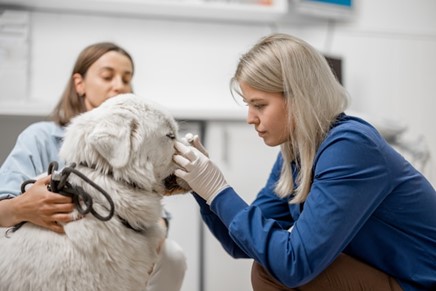Cynthia Maro of Pittsburgh is an integrative veterinarian that holds multiple advanced certifications including DVM, CVA, CAC, VMRT, and VNAET. With a deep passion for holistic animal care, Dr. Maro combines traditional veterinary practices with alternative therapies to offer comprehensive health solutions for pets. In the following article, she provides valuable insights on how to keep your loved ones—both furry and human—safe from tick-borne threats.
Ticks, once considered a seasonal nuisance, are now a year-round threat in western Pennsylvania, a concerning trend attributed to milder weather and encroachment on wildlife habitats by residential areas. Dr. Cynthia Maro underscores this growing concern as she observes an increase in ticks attaching to pets throughout all seasons. This shift is not only impacting animals but also poses significant health risks to humans.
Cynthia Maro Discusses Lyme Disease Facts
Lyme disease has traditionally been a significant concern for veterinarians. However, the landscape of vector-borne diseases (VBDs) has evolved in recent years, presenting a more complex array of health risks for animals and humans alike. While Lyme disease remains a prominent diagnosis, the emergence of other VBDs such as Anaplasma, Ehrlichia, and Babesia has added to the challenges faced by veterinary professionals.
Anaplasma, transmitted by the same Ixodes ticks responsible for Lyme disease,
infects white blood cells and can cause fever, lethargy, joint pain, and potentially severe illness if left untreated in humans.
Ehrlichia, another
bacterial infection transmitted by ticks, targets white blood cells and platelets, leading to symptoms such as fever, lethargy, anemia, and bleeding disorders in dogs.
Babesia, a
parasite transmitted through tick bites, infects red blood cells, and can cause symptoms ranging from mild fever and lethargy to severe anemia and organ failure.
The coexistence of these infections alongside Lyme disease underscores the necessity for heightened vigilance in prevention and early detection. Cynthia Maro of Pittsburgh stresses the importance of pet owners being proactive in protecting their animals against ticks and seeking veterinary care promptly if symptoms suggestive of these illnesses arise. Given the nonspecific nature of warning signs associated with many tick-borne diseases, timely diagnosis and treatment are critical to preventing more severe health complications.
Furthermore, the geographical distribution of tick-borne illnesses may vary, with certain regions experiencing higher prevalence rates of specific diseases. This variability necessitates tailored prevention strategies based on local pest populations and disease prevalence data. Veterinary professionals play a crucial role in educating pet owners about regional risks while recommending appropriate preventive measures, including topical or oral tick control products.
While Lyme disease remains a significant concern, the emergence of infections such as Anaplasma, Ehrlichia, Babesia, and other severe diseases highlights the evolving nature of tick-borne illnesses. Pet owners are encouraged to stay informed about local tick risks, implement effective preventive measures, and promptly seek veterinary care if their pets show signs of infection. By working closely with veterinarians and adhering to recommended tick prevention practices, pet owners can mitigate the risks associated with VBDs and ensure the health and well-being of their beloved pets.
Conventional Treatments for Pets
In recent years, concerns have grown regarding the effectiveness of conventional chemical treatments against ticks, primarily due to reports of resistance developing within tick populations. These resilient parasites, adapting to environmental pressures and chemical exposures, pose a challenge to traditional control methods. As a result, Cynthia Maro of Pittsburgh emphasizes the importance of using vet-prescribed tick control products consistently and correctly.
Unlike over-the-counter remedies or anecdotal treatments circulating on social media, prescription products undergo rigorous testing for safety and efficacy. These treatments are formulated to target specific stages of the tick life cycle, disrupting reproduction, and ultimately reducing tick populations within the immediate environment. By adhering to a veterinarian's recommendations, pet owners can ensure comprehensive protection for themselves, and their animals against these adaptable parasites.
Cynthia Maro of Pittsburgh underscores the critical nature of using scientifically validated preventive measures to combat tick-borne diseases. While misconceptions about treatments may abound online, relying on vet-prescribed products offers a higher level of assurance against life-threatening VBDs such as Lyme disease, Anaplasma, Ehrlichia, and Babesia. These diseases can have serious consequences for both pets and humans, accentuating the importance of proactive tick prevention strategies.
Moreover, ongoing research and advancements in veterinary medicine continue to inform the development of new tick control technologies. From topical treatments to oral medications, veterinarians can recommend the most effective options based on local tick prevalence and pet-specific considerations. This personalized approach ensures that pets receive optimal protection tailored to their individual health needs.
While challenges may complicate traditional control methods, prescription tick control products remain a cornerstone of effective prevention. By consulting with veterinarians and following their recommendations, pet owners can take proactive steps to safeguard their pets against the growing threat of various tick-borne illnesses. Through education, awareness, and adherence to scientifically validated preventive measures, we can collectively mitigate the risks posed by parasites and promote the health and well-being of our companion animals.

 Safeguarding Your Home from Tick-Borne Risks
Safeguarding Your Home from Tick-Borne Risks
Pets are unwitting carriers of ticks that play a significant role in the transmission of these parasites into homes, where they can persist for extended periods, posing a continuous threat to household members. This dynamic often catches homeowners off guard, especially when they find ticks on their pets, despite limited outdoor exposure. Dr. Cynthia Maro of Pittsburgh stresses the importance of prompt action in such situations.
Immediate and careful removal of any attached tick is crucial to minimize the risk of disease transmission. It is recommended to use specialized tick removal tools, which are designed to grasp the tick close to the skin and facilitate safe extraction, including the removal of mouthparts to prevent residual transmission. This method helps reduce the likelihood of infection from tick-borne pathogens.
Following the removal of the tick, Cynthia Maro of Pittsburgh advises against applying disinfectants directly to the tick itself. Instead, she recommends placing the tick in a Ziplock plastic bag, sealing it securely, and storing it in a cool, dry place. This approach allows for further analysis, if necessary, especially when identifying the specific pathogens carried by the tick. For concerned pet owners, organizations like ticklab.org offers services to test ticks for various vector-borne diseases, providing detailed reports that can guide subsequent medical decisions.
Additionally, Dr. Maro emphasizes that prompt removal and proper disposal of ticks are essential steps in preventing potential health risks for both pets and humans. Ticks can harbor infectious agents for weeks after attachment, making early detection and removal critical to mitigating the spread of disease. By following these guidelines and seeking veterinary advice when necessary, pet owners can effectively manage the risks associated with these parasites and safeguard the well-being of their families and pets alike.
Identifying Tick-Borne Pathogens in Pets
Accurate pathogen identification is crucial for assessing disease transmission risks. This enables swift, targeted medical intervention, potentially preventing the onset of symptoms in both pets and humans. The consequences of untreated VBDs can be severe, ranging from blood disorders and arthritis to acute kidney failure in pets, underscoring the importance of early detection and preventive care.
Ehrlichia, Babesia, and Anaplasma infections present diagnostic challenges due to their nonspecific symptoms, which may mimic other health conditions. Pets may exhibit intermittent limping, shifting lameness between limbs, anemia, or abnormal bleeding, prompting careful examination by veterinary professionals familiar with local tick disease patterns. Cynthia Maro of Pittsburgh stresses the significance of preemptive treatment before symptoms manifest, reducing the likelihood of debilitating health outcomes associated with tick-borne illness.
 Preventing Illness
Preventing Illness
Preventing VBDs necessitates a comprehensive strategy that goes beyond mere awareness. Dr. Cynthia Maro underscores the importance of proactive measures, emphasizing the regular administration of vet-recommended tick preventatives as a cornerstone of defense. These preventatives not only deter ticks from latching onto pets but also reduce the likelihood of transmission of harmful pathogens.
Staying well-informed is another critical aspect of tick prevention advocated by Cynthia Maro of Pittsburgh. She advises pet owners to rely on credible sources such as the Centers for Disease Control and Prevention (CDC), which provides
extensive guidelines on identifying, preventing, and treating tick-borne illnesses. These resources offer valuable insights into the local prevalence of ticks and the diseases they carry, empowering families to make informed decisions about outdoor activities while also minimizing risks.
By adopting these proactive measures, individuals can create a protective shield against the escalating threat of tick-borne pathogens prevalent in their communities. Regular use of effective preventatives combined with knowledge from authoritative sources equips pet owners with the tools needed to safeguard their families and beloved pets from potentially devastating health consequences associated with tick encounters.
Tick-borne Illness Symptoms to Watch For in Dogs
Here are some of the most common symptoms in dogs that could indicate a tick-borne disease infection:
- Lameness or Limping: Sudden or shifting lameness, where the dog may appear to favor one leg at one time and another leg at another time.
- Fever: Elevated body temperature, often accompanied by lethargy or decreased activity.
- Joint Pain and Swelling: Dogs may show signs of discomfort in their joints, such as swelling, stiffness, or reluctance to move.
- Loss of Appetite: A decreased interest in food or sudden loss of appetite, which may indicate underlying illness.
- Lethargy: Unusual tiredness or lack of energy, where the dog seems more subdued than usual.
- Swollen Lymph Nodes: Enlarged lymph nodes, particularly around the neck, could indicate an immune response to infection.
- Bruising or Bleeding: Unexplained bruising, bleeding from the nose, gums, or other areas, which can be associated with certain tick-borne diseases affecting clotting factors.
- Neurological Signs: Depending on the disease, symptoms may include seizures, changes in behavior, disorientation, or difficulty walking.
- Pale Gums: A sign of anemia, where the gums appear pale due to a decrease in red blood cells.
- Difficulty Breathing: Respiratory distress or coughing, which may occur in diseases like babesiosis that affect the lungs.
- Vomiting and Diarrhea: Gastrointestinal symptoms can occur in some tick-borne illnesses, leading to vomiting, diarrhea, or abdominal pain.
- Jaundice: Yellowing of the skin or eyes, indicating liver involvement in diseases like ehrlichiosis.
It's important to note that symptoms can vary depending on the specific disease and the stage of infection. If you notice any of these symptoms or suspect your dog may have been exposed to a tick bite, it's crucial to seek veterinary attention promptly. Early detection and treatment are key to managing these illnesses effectively and preventing complications.
When to Visit or Contact a Veterinarian
Cynthia Maro of Pittsburgh explains that if you notice any of the symptoms associated with tick-borne illnesses in your dog, it's crucial to promptly contact and seek guidance from a veterinarian. Symptoms such as those highlighted above should not be ignored, and promptly addressed. These signs may indicate a serious infection. Early veterinary intervention is essential for accurate diagnosis through blood tests and appropriate treatment, which may include antibiotics, anti-inflammatory medications, supportive care, and monitoring. Timely veterinary attention can help mitigate the progression of these illnesses and improve the chances of a full recovery for your dog.
 Final Thoughts
Final Thoughts
In closing, Cynthia Maro of Pittsburgh highlights the crucial steps needed to address the increasing threat of tick-borne diseases. With ticks now posing a year-round risk due to changing weather patterns, wildlife behavior and an increase of residential communities near wildlife areas, pet owners must prioritize proactive measures. Regular checks should become a routine part of pet care, particularly after outdoor activities in grassy or wooded areas. Administering veterinarian-recommended preventatives consistently and according to instructions is vital to effectively protect pets from tick bites and the diseases they carry.
Dr. Cynthia Maro also stresses the importance of early intervention. If you notice any symptoms described above in your pet, such as lameness, lethargy, fever, or neurological abnormalities, it’s crucial to seek care promptly. Diagnostic tests can confirm the presence of VBDs, enabling veterinarians to initiate appropriate treatment promptly. This may involve close monitoring to manage symptoms and prevent complications.
Furthermore, staying informed through credible sources such as local veterinary offices, or websites like the CDC and ticklab.org, ensures that pet owners have access to accurate information about possible pathogens and effective prevention strategies. By adopting these proactive measures, pet owners can significantly reduce the risk of their pets contracting tick-borne illnesses and protect their overall health and well-being. Together with regular veterinary check-ups and discussions about disease prevention, these steps form a comprehensive approach to safeguarding pets against the growing threat of tick-borne diseases in today’s environment.
Author
Dr. Cynthia Maro - Integrative Veterinarian, Cynthia Maro, DVM, CVA, CAC, VMRT, VNAET

 Safeguarding Your Home from Tick-Borne Risks
Safeguarding Your Home from Tick-Borne Risks Preventing Illness
Preventing Illness Final Thoughts
Final Thoughts